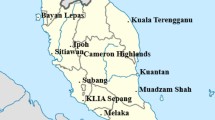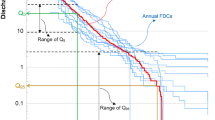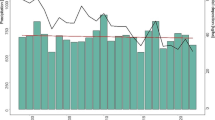Abstract
The present study proposes an integrated framework to optimize environmental flow of the multireservoir systems in which a rainfall-runoff model and a novel form of the reservoir operation optimization are linked. Soil and water assessment tool was utilized as the rainfall-runoff model to forecast inflow of the reservoir. Then, outputs of the rainfall-runoff model were used in the optimization model. Ideal environmental flow regime was considered as the target of the environmental flow in the optimization model based on the outputs of the instream flow incremental methodology proposed by the previous studies in the case study. Moreover, minimum environmental flow regime in the optimization model was defined using penalty function method. Evolutionary algorithms were utilized to optimize the reservoir operation. Then, the performance of the algorithms was assessed by different measurement indices. Finally, the fuzzy technique of order preference similarity to the ideal solution was applied to select the best algorithm. Based on the results in the case study, the proposed framework is properly able to optimize environmental flow regime in the multireservoir system. Measuring the performance of the optimization system indicated that average reliability index is 70% for supplying environmental flow. Moreover, the optimization system is able to minimize storage loss and water supply loss simultaneously. The particle swarm optimization is the best algorithm to optimize environmental flow regime in the case study. Using the proposed method is recommendable to minimize negotiations between stakeholders and environmental managers that might provide a fair balance between environmental requirements and water demand.









Similar content being viewed by others
References
Abbaspour, K. C. (2013). Swat-cup 2012. SWAT Calibration and uncertainty program—a user manual.
Abbaspour, K. C., Rouholahnejad, E., Vaghefi, S. R. I. N. I. V. A. S. A. N. B., Srinivasan, R., Yang, H., & Kløve, B. (2015). A continental-scale hydrology and water quality model for Europe: Calibration and uncertainty of a high-resolution large-scale SWAT model. Journal of Hydrology, 524, 733–752.
Abdoli, A., Sedighkia, M., Nejat, F. (2020). Assessment of environmental flow regime in Jajrood river basin by ecological based method. Technical Report, Iranian Department of Environment, p. 732.
Afshar, A., Haddad, O. B., Mariño, M. A., & Adams, B. J. (2007). Honey-bee mating optimization (HBMO) algorithm for optimal reservoir operation. Journal of the Franklin Institute, 344(5), 452–462.
Afshar, A., Shafii, M., & Haddad, O. B. (2011). Optimizing multi-reservoir operation rules: An improved HBMO approach. Journal of Hydroinformatics, 13(1), 121–139.
Afshar, M. H. (2012). Large scale reservoir operation by Constrained Particle Swarm Optimization algorithms. Journal of Hydro environment Research, 6(1), 75–87. https://doi.org/10.1016/j.jher.2011.04.003.
Altinbilek, D. (2002). The role of dams in development. Water Science and Technology, 45(8), 169–180.
Asgari, H. R., Bozorg Haddad, O., Pazoki, M., & Loáiciga, H. A. (2016). Weed Optimization Algorithm for Optimal Reservoir Operation. Journal of Irrigation and Drainage Engineering, 142(2) 04015055. https://doi.org/10.1061/(ASCE)IR.1943-4774.0000963.
Azizipour, M., Sattari, A., Afshar, M. H., Goharian, E., & Solis, S. S. (2020). Optimal hydropower operation of multi-reservoir systems: Hybrid cellular automata-simulated annealing approach. Journal of Hydroinformatics, 22(5), 1236–1257.
Ball, J. E., Babister, M. K., Nathan, R., Weinmann, P. E., Weeks, W., Retallick, M. & Testoni, I. (2016). Australian Rainfall and Runoff-A guide to flood estimation.
Birhanu, K., Alamirew, T., Dinka, M. O., Ayalew, S., & Aklog, D. (2014). Optimizing reservoir operation policy using chance constraint nonlinear programming for Koga irrigation Dam. Ethiopia. Water Resources Management, 28(14), 4957–4970.
Cai, W., Zhang, L., Zhu, X., Zhang, A., Yin, J., & Wang, H. (2013). Optimized reservoir operation to balance human and environmental requirements: A case study for the Three Gorges and Gezhouba Dams, Yangtze River basin, China. Ecological Informatics, 18, 40–48.
Chen, C. H. (2000). Extensions of the TOPSIS for group decision-making under fuzzy environment. Fuzzy Sets and Systems, 114(1), 1–9. https://doi.org/10.1016/S0165-0114(97)00377-1.
Chen, L., & Chang, F. J. (2007). Applying a real-coded multi-population genetic algorithm to multi-reservoir operation. Hydrological Processes: An International Journal, 21(5), 688–698.
Cheng, C. T., Wang, W. C., Xu, D. M., & Chau, K. W. (2008). Optimizing hydropower reservoir operation using hybrid genetic algorithm and chaos. Water Resources Management, 22(7), 895–909.
Datta, B., & Burges, S. J. (1984). Short-term, single, multiple-purpose reservoir operation: Importance of loss functions and forecast errors. Water Resources Research, 20(9), 1167–1176.
Dokeroglu, T., Sevinc, E., Kucukyilmaz, T., & Cosar, A. (2019). A survey on new generation metaheuristic algorithms. Computers & Industrial Engineering, 137, 106040.
Dumitru, C. and Maria, V. (2013). Advantages and Disadvantages of Using Neural Networks for Predictions. Ovidius University Annals, Series Economic Sciences, 13(1).
Ehteram, M., Karami, H., Mousavi, S. F., Farzin, S., Celeste, A. B., & Shafie, A. E. (2018). Reservoir operation by a new evolutionary algorithm: Kidney algorithm. Water Resources Management, 32(14), 4681–4706.
Gassman, P. W., Reyes, M. R., Green, C. H., & Arnold, J. G. (2007). The soil and water assessment tool: Historical development, applications, and future research directions. Transactions of the ASABE, 50(4), 1211–1250.
Guariso, G., & Sangiorgio, M. (2020). Performance of implicit stochastic approaches to the synthesis of Multireservoir operating rules. Journal of Water Resources Planning and Management, 146(6), 04020034.
Gupta, H. V., & Kling, H. (2011). On typical range sensitivity and normalization of Mean Squared Error and Nash- Sutcliffe Efficiency type metrics. Water Resources Research, 47(10). https://doi.org/10.1029/2011WR010962.
Haddad, O. B., Hosseini-Moghari, S. M., & Loáiciga, H. A. (2016). Biogeography-based optimization algorithm for optimal operation of reservoir systems. Journal of Water Resources Planning and Management, 142(1), 04015034.
Haddad, O. B., Moravej, M., & Loáiciga, H. A. (2015). Application of the water cycle algorithm to the optimal operation of reservoir systems. Journal of Irrigation and Drainage Engineering, 141(5), 04014064.
Hashimoto, T., Stedinger, J. R., & Loucks, D. P. (1982). Reliability, resiliency, and vulnerability criteria for water resource system performance evaluation. Water Resources Research, 18(1), 14–20.
Horne, A., Kaur, S., Szemis, J., Costa, A., Webb, J. A., Nathan, R., Stewardson, M., Lowe, L., & Boland, N. (2017). Using optimization to develop a “designer” environmental flow regime. Environmental Modelling & Software, 88, 188–199.
Jahandideh-Tehrani, M., Bozorg-Haddad, O., & Loáiciga, H. A. (2019). Application of non-animal–inspired evolutionary algorithms to reservoir operation: An overview. Environmental Monitoring and Assessment, 191(7), 439.
Kennedy, J., & Eberhart, R. (1995, November). Particle swarm optimization. In Proceedings of ICNN'95-international conference on neural networks (Vol. 4, pp. 1942–1948). IEEE.
Kirkpatrick, S. (1984). Optimization by simulated annealing: Quantitative studies. Journal of Statistical Physics, 34(5–6), 975–986. https://doi.org/10.1007/BF01009452.
Labadie, J. W. (2004). Optimal Operation of Multireservoir Systems: State-of-the-Art Review. Journal of Water Resources Planning and Management, 130(2), 93–111. https://doi.org/10.1061/(ASCE)0733-9496.
Maddock, I. (2018). Environmental flows: habitat modeling. The Wetland Book: I: Structure and Function, Management, and Methods, pp. 1829–1834.
Maier, H. R., & Dandy, G. C. (2000). Neural networks for the prediction and forecasting of water resources variables: A review of modelling issues and applications. Environmental Modelling & Software, 15(1), 101–124.
Maier, H. R., Simpson, A. R., Zecchin, A. C., Foong, W. K., Phang, K. Y., Seah, H. Y., & Tan, C. L. (2003). Ant colony optimization for design of water distribution systems. Journal of Water Resources Planning and Management, 129(3), 200–209.
Qin, A. K., Huang, V. L., & Suganthan, P. N. (2008). Differential Evolution Algorithm With Strategy Adaptation for Global Numerical Optimization. IEEE Transactions on Evolutionary Computation, 13(2), 398–417. https://doi.org/10.1109/TEVC.2008.927706.
Rashedi, E., Nezamabadi-Pour, H., & Saryazdi, S. (2009). GSA: A gravitational search algorithm. Information Sciences, 179(13), 2232–2248.
SaberChenari, K., Abghari, H., & Tabari, H. (2016). Application of PSO algorithm in short-term optimization of reservoir operation. Environmental Monitoring and Assessment, 188(12), 667.
Sangiorgio, M., & Guariso, G. (2018). NN-based implicit stochastic optimization of multi-reservoir systems management. Water, 10(3), 303.
Soncini-Sessa, R., Weber, E., & Castelletti, A. (2007). Integrated and participatory water resources management-theory. Elsevier.
Spiliotis, M., Mediero, L., & Garrote, L. (2016). Optimization of hedging rules for reservoir operation during droughts based on particle swarm optimization. Water Resources Management, 30(15), 5759–5778.
Teegavarapu, R. S., & Simonovic, S. P. (2002). Optimal operation of reservoir systems using simulated annealing. Water Resources Management, 16(5), 401–428.
Tharme, R. E. (2003). A global perspective on environmental flow assessment: Emerging trends in the development and application of environmental flow methodologies for rivers. River Research and Applications, 19(56), 397–441.
Whitley, D. (1994) A genetic algorithm tutorial. Statistics and Computing, 4(2). https://doi.org/10.1007/BF00175354.
Yang, X. S., & Gandomi, A. H. (2012). Bat algorithm: a novel approach for global engineering optimization. Engineering Computations, 29(5), 464–483. https://doi.org/10.1108/02644401211235834.
Yang, X. S., & He, X. (2013). Bat algorithm: Literature review and applications. International Journal of Bio-Inspired Computation, 5(3), 141–149.
Yaseen, Z. M., Allawi, M. F., Karami, H., Ehteram, M., Farzin, S., Ahmed, A. N., Koting, S. B., Mohd, N. S., Jaafar, W. Z. B., Afan, H. A., & El-Shafie, A. (2019). A hybrid bat–swarm algorithm for optimizing dam and reservoir operation. Neural Computing and Applications, 31(12), 8807–8821.
Yeh, W. W. G. (1985). Reservoir management and operations models: A state of the art review. Water Resources Research, 21(12), 1797–1818.
Yin, X. A., Yang, Z. F., & Petts, G. E. (2012). Optimizing environmental flows below dams. River Research and Applications, 28(6), 703–716.
Zhao, T., Zhao, J., & Yang, D. (2014). Improved dynamic programming for hydropower reservoir operation. Journal of Water Resources Planning and Management, 140(3), 365–374.
Funding
Not applicable.
Author information
Authors and Affiliations
Corresponding author
Ethics declarations
Conflicts of interest
The authors that they have declare no conflict of interest.
Additional information
Publisher's Note
Springer Nature remains neutral with regard to jurisdictional claims in published maps and institutional affiliations.
Rights and permissions
About this article
Cite this article
Sedighkia, M., Abdoli, A. Design of optimal environmental flow regime at downstream of multireservoir systems by a coupled SWAT-reservoir operation optimization method. Environ Dev Sustain 25, 834–854 (2023). https://doi.org/10.1007/s10668-021-02081-w
Received:
Accepted:
Published:
Issue Date:
DOI: https://doi.org/10.1007/s10668-021-02081-w




